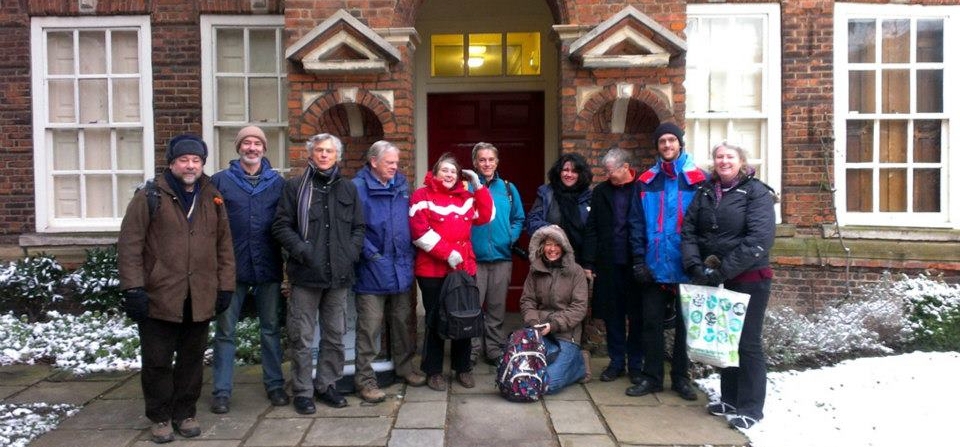Archaeology Committee Workshop primarily field trip based exploring Iron Age East Yorkshire.
Iron Age East Yorkshire
Archaeology Committee Workshop 2013
22nd-24th March
Hull, Yorkshire
Organised by Peter Halkon

This conference was primarily field trip based, with highlights including;
- Guided tour of prehistoric iron production sites in the region.
- A guided visit to the Arras barrow cemetery site.
- Reception and exclusive viewing of the South Cave Weapons Cache, a Late Iron Age cache of five iron swords in ornate La Tene scabbards and 33 iron spearheads discovered in East Yorkshire.
- Guided tour of the Hull and East Riding Museum.
Photo Gallery
Review
In March some HMS members braved snow and icy winds to attend the Archaeology Committee Spring Workshop which had been organised by Peter Halkon and Yvonne Inall from the University of Hull. A combination of museum visits and field trips was arranged to illustrate the theme of Iron Age ironworking.
The meeting began with a Friday evening reception at the aptly-named Treasure House in Beverley. This combined library, archive and museum building opened in 2007 and holds the archaeological collections of the East Riding Museums Service. Here, delegates were able to see the very impressive cache of Iron Age swords from South Cave, discovered by metal detectorists in 2002.
Some members of the group also took advantage of the opportunity to wield a replica sword, made in 2009 by Roland Williamson. After the reception, delegates repaired to the accommodation in Hull, at the delightful Endsleigh Centre. This was built in 1901 as a Convent of the Sisters of Mercy and included a training College. The College closed in the 1970s and since 1995 the Endsleigh Centre
has been a retreat and conference centre – still run by the very friendly and welcoming Sisters.
Overnight snowfall greeted delegates the following morning. Undeterred, the group boarded the minibus to explore some Iron Age sites and landscapes under the expert leadership of Peter Halkon, who has known this landscape since childhood and has been involved in many of the most important excavations. Some delegates took a while to get accustomed to the East Yorkshire definition of ‘hill’; however the icy Russian wind and drifting snow encountered at the famous Arras burial ground convinced most people that this was indeed high ground.
The trip then moved into the relatively low-lying area surrounding the River Foulness, which in the Iron Age was a much larger body of water feeding into the Walling Fen and thence to the Humber. The group investigated two sites, on either side of the former Fen. The first of these was at Moore’s Farm, Welham Bridge, the scene of substantial bog-ore smelting – indeed this was the site of the excavation of the largest slag heap ever found in Iron Age England. Weighing a massive 5338kg, this represented the production of up to between one and two tonnes of bloom (Halkon 2011, 139). Undeterred by the snow and freezing temperatures delegates enthusiastically began fieldwalking, returning to the minibus proudly bearing bits of slag.
The second site was at Hasholme. Famous for its log boat excavated in 1984, the trip explored an adjacent enclosure and again discovered various lumps of slag and bog-ore – along with a very nice decorated greyware rim-sherd. A recent scheme has restored a small area of adjacent wetland to very much its Iron Age appearance, so there was a vivid impression of the former shoreline of the Walling Fen.
The farmhouse kitchen provided a welcome warm break during which delegates were able to inspect an impressive collection of portable antiquities discovered by the farmer over the years.
After lunch at the Red Lion in Holme-upon-Spalding Moor, the workshop returned to Hull where an enjoyable afternoon was spent in the East Riding Museum. Peter led a tour of the galleries. Although the focus on the Iron Age meant inevitable enthusiasm for items such as the North Grimston Sword, there was also an impressive collection of Roman and medieval metalwork. The Museum also houses the Hasholme boat, although sadly the conservation programme was stopped in 2009 leading to some deterioration in its condition.
A quick pint at the Black Boy was followed by a very nice dinner at Princes Quay, and some delegates followed this with further drinks at the George.
Sadly the trip planned for the following morning was cancelled, due to snow and looding. Some delegates made their way to Beverley, for a pleasant morning inspecting the Minster and various items of cast-iron street furniture. This was a hugely enjoyable meeting, despite the weather; many thanks to Peter and Yvonne for organising it.
![[Test] The Historical Metallurgy Society](https://test.historicalmetallurgy.org/wp-content/uploads/2020/02/Logo120.png)
